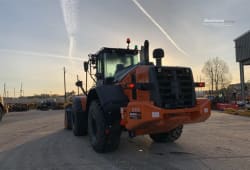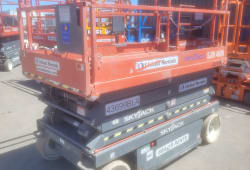Caterpillar Skid Steer Troubleshooting
5 Min read
)
October 1, 2023
CAT skid steers are powerful workhorses, but like any machinery, they can encounter issues that affect their performance. Whether you're using a CAT skid steer for construction, landscaping, or other tasks, understanding common problems and how to troubleshoot them is essential for smooth operation.
In this guide, we'll walk you through seven common issues and their troubleshooting solutions to keep your CAT skid steer running smoothly.
1. Low Hydraulic Fluid Level
One of the most common problems with CAT skid steers is a low hydraulic fluid level. This can reduce the hydraulic system and pump performance, affecting the machine's ability to lift its loader arms and operate attachments.
:format(webp))
Troubleshooting
To resolve this issue, consult your skid steer's operation and maintenance manual for the specific hydraulic fluid type and fill level requirements. Check the hydraulic fluid reservoir under the operator's seat or in the engine compartment.
If the level is low, add the recommended hydraulic fluid until it reaches the specified level. Be cautious not to overfill, as it can lead to other issues.
2. Unresponsive Hydraulic System
Your CAT skid steer machine's hydraulic system is critical to its operation. If the hydraulic system becomes unresponsive, it can hinder the machine's movements and functions.
:format(webp))
Troubleshooting
Start by inspecting the hydraulic hoses and hydraulic pump for any visible damage or leaks. Tighten loose connections and replace damaged hoses if necessary. Ensure that the hydraulic pump is working correctly and has no loose wiring or control issues.
If the hydraulic issues persist, consult your operation and maintenance manual for guidance on troubleshooting the specific hydraulic system components.
It's best to call a certified technician for further diagnosis and repairs if unsure.
3. Sluggish Performance
A noticeable decrease in your skid steer's performance can occur for various reasons, such as clogged filters or worn-out components.
:format(webp))
Troubleshooting
Begin by checking the air and fuel system filters. Replace them with the maintenance manual's recommendations if they are clogged. Inspect the tires for proper inflation; low tire pressure can affect the machine's traction and overall performance.
If the issue persists, consult the manual for additional troubleshooting and repair steps and consider a professional inspection if needed.
4. Electrical Issues
Modern CAT skid steer loaders have electronic control modules and wire harness connectors. Electrical problems can result in erratic behavior and malfunctions.
:format(webp))
Troubleshooting
Examine the wire harness connectors for loose or corroded connections. Ensure that the battery is in good condition and properly connected. If you suspect an issue with the electronic control module, consult your operation and maintenance manual for guidance on troubleshooting and, if necessary, contact a qualified technician to diagnose and resolve electrical issues.
5. Attachment Problems
One of the benefits of a skid steer loader is that it comes with a wide variety of attachments, like a wire harness connector, allowing it to be an extremely versatile work tool. This makes it easy to complete a project with only one type of machine.
Sometimes, CAT skid steer attachments may not function as expected, causing delays and inefficiencies in your work.
:format(webp))
Troubleshooting
Start by checking if the attachment is securely connected to the skid steer's auxiliary hydraulic system. Ensure that all hoses and connections are intact and properly attached.
If the issue persists, consult the attachment's maintenance manual for troubleshooting steps specific to that attachment. Regularly inspect equipment and maintain attachments to prevent issues from arising during operation.
6. Overheating
Overheating is one of the most common engine issues in skid steers, especially during extended periods of operation. This can lead to engine damage and reduced performance.
:format(webp))
Troubleshooting
Check the engine coolant level and ensure it's at the recommended level. Clean the radiator and oil cooler fins to remove debris and dust that may obstruct airflow. Maintain proper engine speed to prevent excessive heat generation.
If replacing the coolant and cleaning the fins does not yield the expected result, consult your operation and maintenance manual for further guidance or seek professional assistance to address any underlying issues.
7. Unusual Noises
Unusual noises coming from your CAT skid steer can indicate potential problems. These noises may indicate issues with the engine, hydraulic systems, or other components.
:format(webp))
Troubleshooting
Identify the source of the noise and try to narrow down its origin. Check for loose or damaged components, such as belts, pulleys, or bolts.
If the noise is related to the hydraulic system, consult your maintenance manual for guidance on inspecting hydraulic components. Addressing unusual noises promptly can prevent further damage and costly repairs.
Conclusion
:format(webp))
In conclusion, understanding common problems and their troubleshooting solutions is crucial for maintaining the performance and reliability of your CAT skid steer. Regular maintenance, adherence to manufacturer recommendations, and prompt attention to issues are key to keeping your skid steer operating at its best.
Always consult your operation and maintenance manual for specific guidance, and when in doubt, seek the expertise of a certified technician to ensure the longevity of your CAT skid steer.
By following these guidelines, you can keep your skid steer in top-notch condition and maximize its productivity on the job site.















